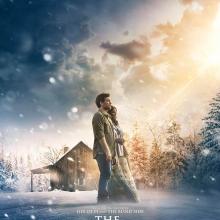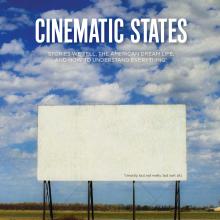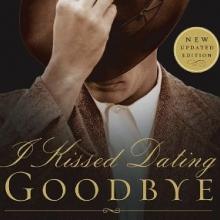movies
Here’s the setup: A shadowy biotech conglomerate and a cabal of satanists (gasp!) are planning to release Lucifer from hell by… wait for it… stealing the linen cloth used to cover Christ’s body during his entombment, using it to clone Christ’s DNA, and then implanting it into a surrogate mother, allowing Lucifer to possess the fetus. The Devil Conspiracy is like a mix of Rosemary’s Baby, Demon Seed, and the surrogacy mix-up romcom The Switch.
IT WOULD HAVE been tough to be both a disciple of Jesus and a foodie. Don’t get me wrong, Jesus certainly valued food — his earthly ministry was filled with meals: The gospel of Matthew describes Jesus as one who “came eating and drinking” (11:19). As Robert J. Karris wrote in Eating Your Way Through Luke’s Gospel, Jesus was “either going to a meal, at a meal, or coming from a meal.” But what the Chosen One had in meal frequency, he lacked in meal diversity.
A “foodie” is someone who eats food as a hobby — a passion, even. The more exotic the better. If you pull up to your local boba shop, why settle for regular milk tea when you can order one infused with butterfly pea flower that turns it bright blue?
However, for Jesus’ meals, at least the ones recorded in scripture, the fish is served broiled (Luke 24:42), not creatively deconstructed. And if you’re rolling with Jesus, you better like eating bread.
Though his plate may have lacked the splendor of the centurions’ or high priests’ spreads, Jesus viewed the table as a radical place of inclusion. For many powerful religious leaders of the time, dining was yet another way to shun the outcasts. In contrast, Jesus intentionally invited those very same “unclean” people to dine with him, breaking bread (because of course it was bread) with tax collectors, sinners, and prostitutes.
In the past year, several films have articulated a hunger for the type of table Jesus championed. Flux Gourmet, Triangle of Sadness, and The Menu critique class inequality through stories revolving around fine dining. In each movie, wealthy people have rich flavors but a dearth of meaningful relationships. The exclusivity of the table seems more important than the actual food served on the plates. Jesus’ table, on the other hand, lacked variety but overflowed in inclusivity — a true palate cleanser to meals that symbolized selfish consumption.
FOR A YEAR defined by isolation, 2020 has been fascinatingly full of stories about relationship. It feels oddly appropriate that during a time when we’re constantly confronting our divisions—ideological and physical—we’ve been surrounded by cinematic reminders of the importance of community and the various ways we find it. Films of 2020 have come out largely through streaming platforms, and we’ve watched them in our homes, by ourselves. They’ve still managed, however, to inspire connection.
Kirsten Johnson’s documentary Dick Johnson Is Dead chronicled her father’s dementia by celebrating her dad’s life, while Natalie Erika James’ horror film Relic addressed the real-life existential terror of watching a loved one’s mind fade to the same disease. Other films such as Spike Lee’s Da 5 Bloods and Sofia Coppola’s On the Rocks examined how adult children relate to their parents’ flaws. Of course, family doesn’t have to mean the people we share our genes with. Movies this year addressed found families too, from Crip Camp’s community of disability activists to The Old Guard’s fiercely devoted group of immortal warriors. Even popcorn fare such as Bill & Ted Face the Music celebrated the way long-standing bonds support us throughout our lives and help us in turn to love others.
Every moment feels true to life, and the literal waves — the peaks of emotion and the sinking tragedies — carry viewers up and down, a rhythm as unpredictable as it as captivating. WAVES is a film for 2019, that does not shy away from the music and actions of teenagers living in 2019.

Rob Young/ flikr.com
I GREW UP with Raiders of the Lost Ark—wildly entertaining, dancing brilliantly with movie craft, speeding up and slowing down in perfect measure, delicious humor and giant thrills aplenty.
But like us all, the filmmakers were subject to the prejudices, pressures, and knowledge of their time. So Raiders stereotypes the “Arab street,” and its casual approach to violence, while typical of action cinema, is ugly. The joy of the ride makes it easy to ignore that Raiders is about a Westerner using Africans to get a Middle Eastern sacred object into an American museum. It may be taking things more seriously than they deserve to even mention this, when the goal was merely a hugely enjoyable Saturday morning serial throwback. The problem with Raiders may be only visible in retrospect—it’s certainly not a bad film; just a popular one with gaps.

Image via The Shack Facebook.
The Gospel isn’t simplistic, and its representations shouldn’t be, either. If The Shack were created with this creed in mind, perhaps it would be a better work of art. Instead, sadly, it’s nothing more than a religious tract.
There are many reasons to recommend Brooklyn — its relatable story for one, its glowing visuals and performances for another. But Brooklyn’s commendable qualities go far beyond this, including the amount of respect writer Nick Hornby and director John Crowley give the movie’s female protagonist. Brooklyn is a movie about hard choices, and for the most part, Eilis makes those choices on her own. At different points in the film, she’s caught between romantic relationships, and familial and personal obligations. But in none of these situations does it feel like her hand is forced. The movie lets us know early that Eilis can take care of herself, and she’s never forced to compromise on that point, though she easily could have been.
Although politics aren’t really on Brooklyn’s agenda, the film also carries an unintentional point on that score worth considering. At a time when the United States is anxious about welcoming refugees and immigrants, this film reminds us that our country is made up largely of immigrants — some who look like Eilis, but also many who don’t.
The Jesus of pop culture is multiethnic and well-traveled, pious and irreverent, singing and silent. A fictional portrayal that is blasphemy to one viewer is sacred to another. The diversity of Jesus’ depictions reflects the diversity of the pop culture audience. Most recently, another fictional Jesus has appeared in Compton, smoking weed and promoting “black-Latin” reconciliation in the new comedy Black Jesus. The sitcom presents a Jesus who uses at times crude language to ultimately promote a consistent gospel message of love. While this Jesus “shares in the pleasures” of his largely poor, African-American community, “he also challenges their prejudices, violence, and self-seeking.” Read more in Danny Duncan Collum’s “The Christ of Compton” (Sojourners, November 2014).
Check out this list to read about five portrayals of Jesus in recent pop culture history.
1. Lion Jesus
In The Chronicles of Narnia, C.S. Lewis sets up a less than subtle allegory of Jesus in the form of a lion named Aslan. Aslan transforms a void into a world through song. He welcomes children. He dies and comes back to life. But still, he is a lion, fierce and elusive, helping to convey both the intimidating power and the radical love of Jesus.
“‘Safe?’ said Mr. Beaver; ‘don’t you hear what Mrs. Beaver tells you? Who said anything about safe? ‘Course [Aslan] isn’t safe. But he’s good. He’s the King, I tell you.’” –The Lion, The Witch, and The Wardrobe (1950)
Two new movies that aim to attract a faith-based crowd join a glut of biblical films for 2014, testing the limits of Hollywood’s appetite for religion.
The two films, “The Good Lie” and “Left Behind,” both opening Oct. 3, reflect two different filmmaking strategies: One is geared for a wider audience that could attract Christians, while the other produces a movie clearly made for the Christian base.
With a number of films targeting a faith audience this year, it’s unclear whether Hollywood is oversaturating the market with faith-based films — a revolutionary idea 10 years after Mel Gibson’s “The Passion of the Christ” shocked the industry by raking in $611.9 million worldwide.
“The Good Lie,” starring Reese Witherspoon helping four young “Lost Boys” from Sudan adjust to life in the U.S., has underlying faith themes. The refugees rely on their faith as they try to leave homeland strife behind, and Witherspoon’s character works closely with a faith-based agency to place refugees with families.
This Friday, a movie version of the classic novel “The Giver” opens in theaters with an impressive cast, including Oscar winners Meryl Streep and Jeff Bridges. “The Giver,” originally written by Lois Lowry, explores a seemingly perfect world where all conflicts have been resolved and annoyances — such as bad weather and adolescent “stirrings” — have been eradicated, allowing this culture to achieve a beautiful state of “sameness.”
As you can imagine, this utopian society is not so utopian. “The Giver” focuses on young Jonas, who has been selected for a daunting task: to serve as society’s sole proprietor of memory and emotion. Jonas learns about pain and sadness, but also experiences beautiful colors, a thrilling sleigh ride and ultimately learns to feel love. In other words, Jonas learns what it means to be human — and that his world may not be so perfect after all.
“The Giver” is the latest in a wave of dystopian stories that have washed over America in recent years. From this summer’s “Purge” sequel and “Under the Dome” to the latest “Hunger Games” movie (due out in November), people can’t get enough of these apocalyptic fantasies, in which seemingly perfect worlds turn horrific.
Why such an appetite for dystopian stories now?
THERE ARE apparently 2,000 film festivals around the world, so the format of red carpet arrivals, gala screenings, and Q&A sessions that appear all but scripted in advance have become well and truly entrenched. The best festivals recognize that their purpose is to cast a spell over filmgoers and filmmakers alike, inviting them into a spacious place where the heart of the dream that led to the film being made and the audience’s reason for watching it can beat in a community of people who thirst for art that gives life. Unsurprisingly, the biggest festivals find it hardest to pull this off—asking for contemplative mutuality at Cannes or Sundance is like looking for a Buddhist tea garden at Disney World.
Yet film festivals can be places where small is indeed beautiful. It’s only the movies that need to be big—or at least their capacity to alchemize with the viewer’s autobiographical narrative. The trappings of VIP lounges, paparazzi, and celebrity gossip are just that: They trap the aesthetic air, creating distance between people and art. Smaller festivals may be more capable of nurturing something that really feels like community.
So when at North Carolina’s Full Frame Documentary Film Festival this spring we watched Visitors, Godfrey Reggio’s follow-up to his epochal Qatsi trilogy, and the diverse faces of human beings segued into natural landscape and a Louisiana cemetery, the sense of empathic connection with an artist who spent the first 14 years of his life in New Orleans and the next 14 as a Christian Brothers monk was palpable. The impossible-to-categorize musician Nick Cave portrayed a sly version of himself in the pseudo-documentary 20,000 Days on Earth, intercutting concert footage with a role-played therapy session, visits with friends, and a neo-noir road trip, to moving effect. And the gay rights courtroom drama of The Case Against 8 played to an audience of citizens whose state had adopted a constitutional amendment to ban same-sex marriage; the showing led to near-euphoric anticipation of how a better history can reverse this tide.
Tom Junod of Esquire wrote an insightful piece about the death of Philip Seymour Hoffman titled “ Philip Seymour Hoffman’s Final Secret: The cost of holding up a mirror to those who could barely stand to look at themselves .” The whole article is worth reading, but these words are especially important:
"There was no actor, in our time, who more ably suggested that each of us is the sum of our secrets … no actor who better let us know what he knew, which is that when each of us returns alone to our room, all bets are off. He used his approachability to play people who are unacceptable, especially to themselves; indeed, his whole career might be construed as a pre-emptive plea for forgiveness to those with the unfortunate job of cleaning up what he — and we — might leave behind."
In his roles, Hoffman played unacceptable, despicable, and broken characters. In other words, he played our cultural scapegoats. But the beauty of Hoffman’s work is that he humanized our scapegoats. Of course, his characters were unacceptable because they were guilty of being repellent jerks, underserving of love or sympathy, which is exactly why they made good scapegoats. The function of a scapegoat is to unite us in hatred against them, so the scapegoat who seems to us to be completely guilty, like a cartoon villain, the better sense of unity we can form against them. The best scapegoat is one who even agrees with us about just how terrible he is. As Junod writes, Hoffman “used his approachability to play people who are unacceptable, especially to themselves.”
In days of old, God used a burning bush to get Moses’ attention. Today’s prophets are often the truth-telling artists, singers, songwriters, and filmmakers whose modern version of “Thus sayeth the Lord” bursts forth in a stunning, sensual explosion of sight, sound, and touch.
They get our attention, and their prophetic word is visceral. It often goes beneath the rational radar and it can disturb more than it comforts. The annual Sundance Film Festival is like a tribe huddled around a campfire listening to the stories. These stories function like burning bushes, as prophetic calls to action. These films are meant not just to be watched, but to change us and, through us, to change the world.
Here are some of the messages I heard at Sundance 2014.
As you make your winter reading list or shop for gifts, consider these 2013 books from Sojourners magazine staff and contributors. Or, buy yourself a gift for 2014.
Lots of people like movies; Gareth Higgins loves movies. But the founding director of the Wild Goose Festival and long-time peace activist engages popular culture with a different eye than most of us. And he’s used that keen eye for deeper meaning to create his latest book.
I asked Gareth about his new book on American film, his peace work, and what it’s like considering American culture both as an insider and as a non-native. Here’s what he had to say.
Reviews of the new hit movie Gravity note that it’s an unusually fine science fiction film. What they don’t mention is that the main character represents an increasingly common theme in American religion: The spiritual “none of the above.”
Yes, the special effects are splendid. And I’ll take the word of astronauts who say the visuals capture amazingly well what it’s like to work in the microgravity of near-Earth orbit.
But there are moments where spiritual and philosophical themes take center stage.
(Spoiler alert: I’ll give no more away than I’ve seen in most reviews, but if you really want to know nothing about the movie, see it first.)
EVERY SUMMER brings the end of the world. But not since 1998’s Deep Impact and Armageddon both threatened the end of the world with objects from space has there been such apocalypse redundancy in summer blockbusters: This year, class wars, real wars, ecological exhaustion, aliens, and zombie viruses destroyed our planet in as many different ways.
In her excellent e-book The Zombies are Coming!, Kelly J. Baker reminds us that apocalyptic fantasies have been part of the popular American imagination since at least the Puritan hellfire sermon. Even without a common religious narrative to guide them, end-of-the-world stories mostly function as a form of cultural critique and utopian longing. We can only imagine a desired future out of the ashes of the utterly destroyed present. In other words, things are going to have to get a lot worse before they get better.
If Baker is right that we seize on apocalyptic fantasies both to express a deep feeling that something is very wrong with our current state of affairs and to imagine some better alternative, then this summer’s world-ending movies display a profound lack of imagination. Most of them are not even particularly good at conceiving the end of the world, and none of them offer us a vision of how things might be different.
After Earth, for example, is more an overblown coming-of-age story than an apocalyptic thriller. The film follows Kitai (Jaden Smith) as he is guided via walkie-talkie by his wounded father (Will Smith) across an unknown planet. The planet turns out to be Earth 1,000 years after humans have high-tailed it to outer space. But since we never learn why humans had to leave, the apocalyptic frame feels like little more than an excuse to raise the stakes of Kitai’s journey and a chance to show off some fantastic technology. Kitai’s array of super-cool gadgets pretty much guarantees the creatures he meets will have to be more menacing than anything the old Earth could manufacture. The few glimpses we get of humanity’s new planet suggest a post-racial melting pot where everyone speaks a little Chinese and a lot of English and has a preference for flowing linen garments and nautical decoration schemes. I suppose this is a vision of a better tomorrow, but it felt more like a futuristic Pier One ad.
My husband and I basically fell in love via AOL instant message conversations that led to daily email missives and then to phone calls and then, you know, to actually hanging out in person.
We knew each other in ‘real’ life but I was so afraid of saying something stupid in front of him that I basically ignored him, which, as it happens, is not a great way to indicate that you actually really like someone. But IM-ing made me bold.
So, in a way, You’ve Got Mail feels like one of “our” movies since it parallels our story just a little.
“Our” real movie is Ingmar Bergman’s The Seventh Seal, which is a 1957 Swedish movie about a knight returning from the crusades during the Black Death who is engaged throughout the movie in a chess match with Death, so, yeah, basically the opposite of You’ve Got Mail.
We were both at a “movie night” at one of our professor’s homes. I’d known he was going to be there and wrote in my meticulous, OCD handwriting in my journal:
I’m so nervous because Tim Stone is going to be there and I don’t want to find him attractive.
Heaven forbid I find him attractive, right? I had clearly been a little too good at "Kissing Dating Goodbye" (thanks, Josh Harris!) In those days when someone asked me out for coffee I usually responded with horror, like they’d just ask me to help dispose of a body.
This week an online ad informed me that Monsters University has finished first at the box office for two weeks running. I’m convicted by the statistic; I saw it somewhere between Northfield, Minn., and the Twin Cities on the “Largest Movie Screen in Minnesota” last week while visiting my brother. But it struck me that the movie presents – probably quite by accident – an opportunity to talk about a deep moral reality. So what follows will only begin obliquely by talking about cute monsters. And it will contain (mostly minor) spoilers. You’ve been warned.
Superman has always had a bit of a messiah complex, born as a modern-day Moses in the imagination of two Jewish guys during the Depression and over the years developing and amplifying his Christlike characteristics.
So it made sense that Warner Bros. Pictures spared no effort in using the Jesus connection to attract the increasingly important Christian audience to see the latest film in the Superman franchise, Man of Steel.
The studio hired a leading faith-based marketing agency, Grace Hill Media, to hold special screenings for pastors, and it developed an extensive website of Christian-themed resources — including specially-edited trailers for use in churches and Man of Steel sermon notes.
















